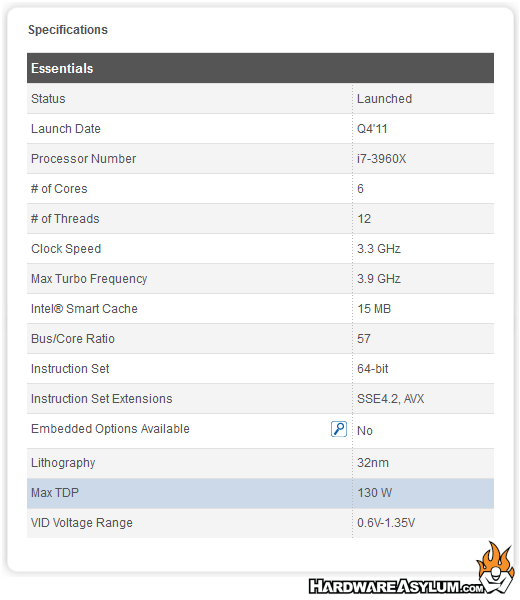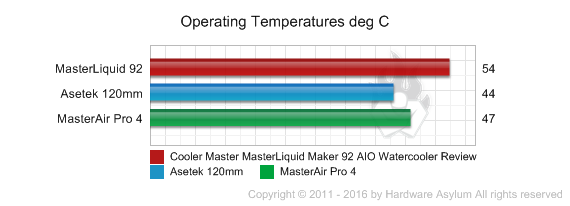Cooler Master MasterLiquid Maker 92 AIO Watercooler Review
Author: Dennis GarciaBenchmarks
The Cooler Master MasterLiquid Maker 92 is designed for Intel Socket LGA2011 / 1156 / 1155 / 1150 and AMD processors. Here is an overview of the system and testing methodology.
Asus P9X79 - X79 Chipset
Intel Core i7 3960x (3.3Ghz) Hex Core 6 x 256KB L2 Cache 15MB L3 Cache
Cooler Master MasterLiquid Maker 92 (Dual Fan)
Asetek OEM (Single Fan 27mm rad)
Cooler Master MasterAir 4 (Single Fan)
The CPUID System Monitor was used to obtain and record system temperature data and being that this is a quad core processor we need something that will work across all of the cores at once. For this task we're using a new version of Prime95 (p95v255a) that will allow you to spawn (n) instances to test with.

Editors note: Even though the Windows 7 task manager reported 100% processor usage we could never attain a 100% of the rated heat output as documented by Intel (see below) when using Prime95 as a basis for that heat production. Knowing this we ran the stress test until the maximum temperature was attainted and stabilized.
Other things to consider when judging software induced heat output.
a) Clock throttling by the processor at high temperatures.
b) Normal software isn't designed to produce maximum heat output.
c) Variances of cooling temperature.
d) Variances in CPU load.
e) Inaccuracies in thermal diode readouts.
Of course the list goes on..
Our testing methodology is aimed to provide a real world look into this heatsink given the test system provided.

A C/W rating can quickly be calculated using this formula.
C/W = (CPU temp - Ambient temp)/(Variance(%) * CPU Watts)
Allowed variance for this test = 85%
CPU Watts = 130W
0.28 C/W = (54C - 23C)/(.85(130W))
For this next test the CPU speed was cranked up to 4.4Ghz and the test was re-run.

To calculate a new C/W rating for this test we will need to factor in the increased processor wattage. The formula and constants for this are listed below.
ocC/W = dCPU Watts * (ocMhz / dMhz) * (ocVcore / dVcore)2
ocMhz = 4400
dMhz = 3300
ocVcore = 1.3
dVcore = 1.2
The variance still applies for our C/W calculation
Allowed variance for this test = 85%
CPU Watts = 203W
0.21 C/W = (60C - 23C)/(.85(203W))
In our heatsink and waterblock tests we don't really focus on overall load temperatures but rather how well the product can remove heat given a specified heat load. Since this is a real world testing method we need to take into consideration real world variables and estimate tolerances. This is why we normally only apply 85% of the total wattage output to our heat calculations.
The resulting C/W number is used to rate how efficient a heatsink or waterblock is based on the given heat load. These numbers can be used to determine heat capacity, the larger the difference the less efficient the heatsink is. (aka not good for overclocking)
As the benchmarks show the cooler struggled on the X79 test bench by posting a higher temperature over the 120mm competition. This may have been a little unfair given the surface area difference but, this is what I felt would have been the competition for this cooler. Despite having smaller fans and a much smaller radiator the MasterLiquid Maker 92 is quite efficient although starts to show its limits under the overclocking test.
You will notice that the C/W rating went down between the two tests which is normally a good thing however in this situation the difference is due to the second fan kicking in and running at near full RPM. You see to control noise Cooler Master programmed the fans to come on in stages based on the RPM signal coming from the motherboard. Full speed will spin them both at 100% while our Turbo profile would only spin one fan under normal usage.
Keep in mind these calculations are provided for demonstration purposes only and may not reflect the actual lab tested C/W rating, but we're pretty close.

